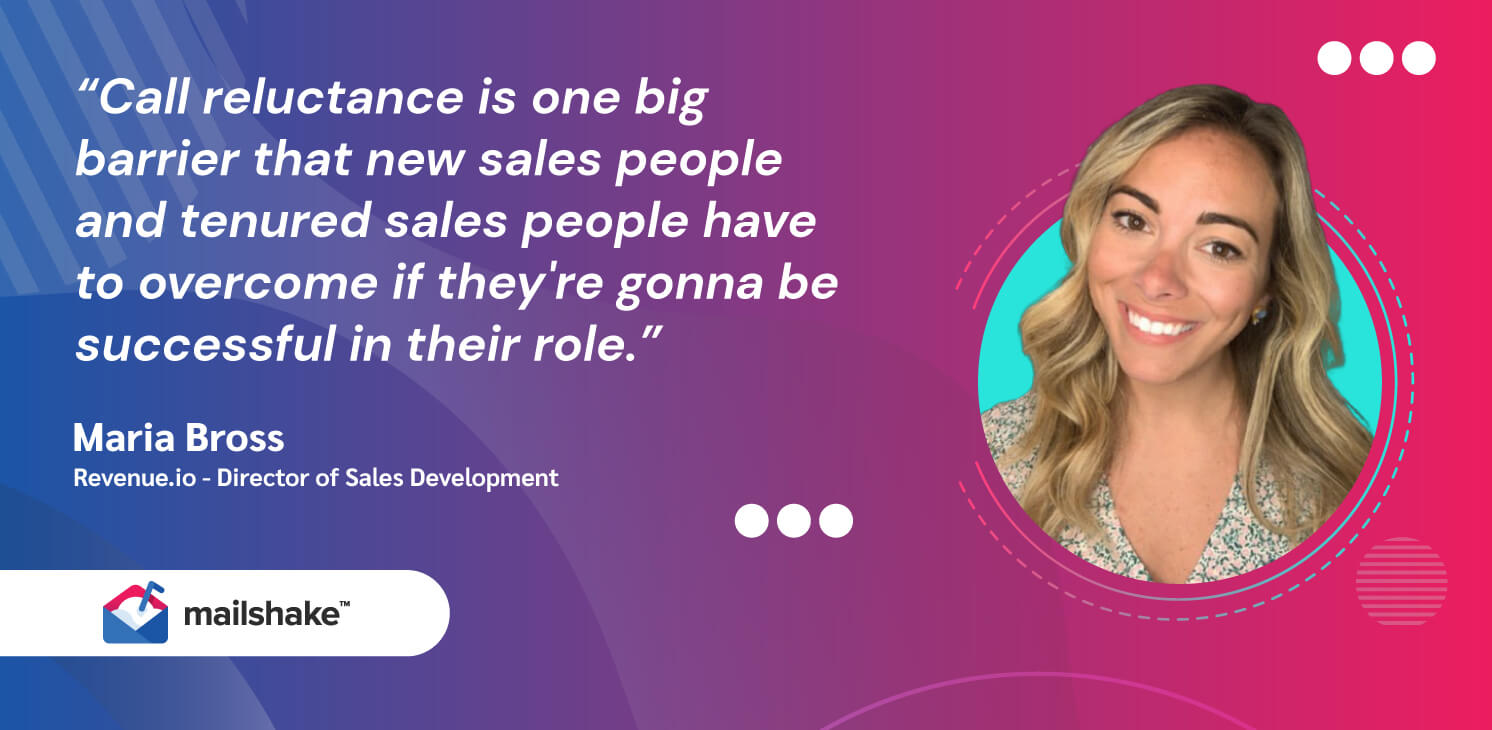How To Overcome Call Reluctance

Contents
40% of veteran sales professionals admit having call reluctance episodes severe enough to threaten their continuation in sales at least once in their life.
That’s almost half the sales people out there. And we’re not even talking about beginners.
Unfortunately, Maria Bross — the director of sales development at Revenue.io — was no exception to this. But we all grow out of our fears, and so did Maria.
She has more than a decade’s worth of experience in sales, and transitioned into a leadership role 2 years back. She’s built a successful sales enablement program that has helped hundreds of up and coming sales professionals fight debilitating issues like call reluctance.
We decided to interview her to learn from her experience and share it with readers like you.
So read ahead to learn what call reluctance is, why it happens, and how to overcome it as you step into the cold, cold world of cold calling.
What is Call Reluctance?
Simply put, call reluctance is the fear of picking up the phone. You can experience call reluctance both in your personal and professional lives, but we’re going to keep this piece focused on call reluctance in the context of sales.
Signs that you’re experiencing call reluctance include:
- Over-preparing for your calls
- Over-thinking about your calls
- Despising your role (although there can be many other reasons behind this)
- Procrastinating excessively at work
Interestingly, Maria revealed that even after a decade of experience in sales, she still experiences call reluctance! This means it’s nothing abnormal — and there is nothing wrong with you if you start sweating every time you have to pick up the phone. This is especially true for beginners because the world of cold calling can be really harsh.
But why are so many people reluctant to prospect via phone (when they don’t mind writing an email or sending a LinkedIn message)? Well, Maria has some interesting insights to share.

What are the reasons behind call reluctance?
According to Maria, one of the biggest reasons behind cold reluctance is the recent paradigm shift that has changed our preferred mode of communication from phone calls to text messages.
This is especially true for Gen Z, who are not used to being on the phone at all (even in their personal lives).
In this context, call reluctance doesn’t stem from the fear of rejection. Instead, it stems from the unfamiliarity of phone calls that has become prevalent over the last few years.
This is no different than Gen Z being reluctant about sending hand-written letters. They won’t be afraid per se — just uncomfortable.
Of course, the fear of rejection is a legit reason behind call reluctance. This is especially true in the world of cold calling, when you’re not sure how your message is going to be received.
Another important reason behind call reluctance is lack of organizational support and training. Remember, cold calling is a difficult art to master and it needs to be practiced over and over again. In this regard, organizational support and training material becomes crucial for newcomers.
If beginners are forced to work in a competitive environment instead of a cooperative one, they’re bound to face call reluctance. This is not only due to the fact that they’re untrained, but also because they have this pressure to outperform others on the team. We’ll discuss how Maria addresses this issue at her company in the next section.
3 Ways to Overcome Call Reluctance?
Maria believes there are 3 major ways that sales individuals and teams can overcome call reluctance:
- Conducting well-researched cold outreach
- Allowing yourself and your team creative freedom and comfort
- Keeping your messaging and strategy fresh
1. Conduct well-researched cold outreach
Conducting well-researched cold outreach is one the most important things you can do to overcome cold reluctance.
When you know your prospect well and understand that your call can help them, your confidence automatically goes up.
You’re no longer a sleazy salesman going in blindly. Instead, you become a saintly helper who knows exactly the solution to your prospect’s problems.
But it’s not only about researching an individual prospect before calling them. It’s also extremely important to have an understanding of the “status quo” — the general trigger points of your audience. Even if you don’t know too much about your prospect, a general understanding will give you the confidence that you might be able to help them.
So if you’re feeling anxious before calling someone, simply ask yourself if your call is going to benefit them. Your reluctance will wash away if your answer is in the affirmative.
2. Allow yourself and your team creative freedom and comfort
Maria believes creative freedom and comfort are two of the most important factors in bringing down call reluctance.
When you’re forced to be someone you’re not, your confidence is bound to plunge. For example, an SDR at Maria’s company has a thick Alabama accent. Instead of asking her to tone it down, Maria has asked her to embrace it, allowing her to stand out and be herself.
Speaking of standing out, creativity also allows you to do something different than the run-of-a-mill cold call. This in itself is a confidence-booster, and helps you tackle call reluctance.
Maria recommends that all sales professionals and teams should do the following to ensure they are comfortable (and hence creative) during calls:
- Adopt the language you use in normal life to stay comfortable.
- Don’t stifle yourself in the name of professionalism and formality.
- Don’t be afraid to try out new things. Cold calling is a pretty boring job — the more fun you can make it, the less likely you are to experience call reluctance.
- Don’t try to sound smart — it’s never a good idea to throw in SAT words during a cold call. If you try to win an argument and sound smart, your calls are going to turn really uncomfortable, increasing your call reluctance.
- Don’t try to copy the top player of the team. Many new sales professionals tend to do this (and Maria has done it as well). But instead of copying the top player of the team, it’s better to emulate someone who you can relate with in terms of style and prospecting.
3. Keep your messaging and strategy fresh
Last but not the least, keeping your messaging and strategy fresh is crucial for overcoming call reluctance. If you know what you’re saying is outdated and won’t resonate with your prospect, you’re bound to feel reluctant in calling them.
Here are Maria’s suggestions on how you can keep your messaging fresh:
- Encourage your team to join platforms like and Mailshake’s Shake Sales or Tuesday Teardowns. This will help you and your team discover new strategies, allowing you to keep things fresh.
- Allow creative freedom. As discussed above, being creative and allowing creative freedom to your team is crucial for reducing cold reluctance. It’s also a good way to keep your messaging fresh, bringing down call reluctance even more.
- Listen back to your calls and understand what the market cares about and what’s getting stale. This is especially important for team leaders, so they can provide data-driven feedback to their team and redirect their messaging in the right direction. It will also help you discover new angles and new problems that you could solve.

Final words
So that was it. If you take only two words from this blog post, they should be “comfortable” and “creative”. These two Cs will prove super-useful in helping you and your team overcome call reluctance.
We hope Maria’s experience and ideas help you and your team become better sales professionals, something that we strive for at Mailshake.





